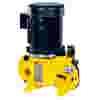A pulsation dampener, also known as a pulsation dampener or pulsation dampener vessel, is a device used in fluid systems to reduce pressure fluctuations or pulsations caused by reciprocating pumps, compressors, or other pulsating flow sources. It is designed to absorb or dampen the rapid pressure fluctuations, thereby providing a more stable and uniform flow.
Pulsation dampeners are commonly used in various industries where precise and consistent fluid flow is critical. They can be found in applications such as oil and gas pipelines, chemical processing plants, water treatment systems, and hydraulic systems.






